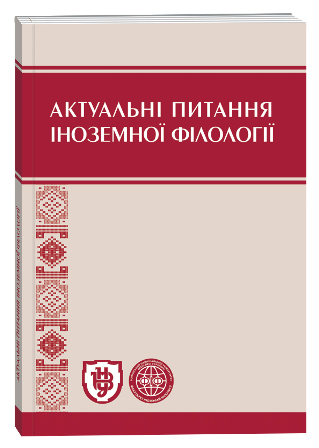CHALLENGES AND PERSPECTIVES OF DIGITALIZED COMMUNICATION
DOI:
https://doi.org/10.32782/2410-0927-2021-15-4Keywords:
Internet discourse, digitalized communication, addresser, addressee, Artificial Intelligence assistantAbstract
The article focuses on contemporary digitally-based communication (computer discourse, Internet discourse). The aim of the article is to present the overview of the general features of digitalized communication, including the new perspectives of studying its addressee and addresser roles. Methods of research are deductive analysis, synthesis, interpretive and semantic analysis, linguistic modeling. Novelty of research. Digitalized communication involves a variety of «addresser» and «addressee» roles which include Artificial Intelligence agents or at least technology assisted human communicators. The article raises a number of issues connected with transformation of traditional sender and receiver roles in digitalized communication, as well as its influence on the language use and semantic interpretation practice. Conclusions. Internet discourse (ID) is a multifaceted concept that has become the center of research in linguistics and many related disciplines as it combines traditional definitions of discourse with the features of modern digitalized communication. Due to its uniqueness, it is regarded as an independent form of discourse. Its hybrid nature (that of spoken and written conventionally defined discourse) can be specified by functional features, genre diversity, information transmission channel, target audience, types of communication means, stylistics, communication strategies, as well as subject area. The specific features of digitalized communication are transformed nature of communication due to the lack of information about the addressee and the addresser, which involves low protection against misrepresentation and manipulation of information; non-human agents that can act as communicators or at least assist human communicators; blending of features of oral and written speech; structured and organized practice of using visual iconic patterns.
References
Більовська І. Категорії “автор-адресант” як знакові характеристики досягнення ефективності сучасних медіатекстів. Вісник Львівського університету. Серія: Журналістика. 2018. С. 212–217.
Гудзь Н. О. Інтернет-дискурс як новий тип комунікації: структура, мовне оформлення, жанрові формати. Сучасні лінгвістичні студії : навчальний посібник. Житомир : Вид-во ЖДУ ім. І. Франка, 2015. С. 61–87.
Зайцева С. В. Інтернет спілкування як нова форма міжособистісної комунікації. Дослідження з лексикології і граматики української мови. Дніпро, 2012. Вип. 11. C. 45–53.
Кримова А. В. Особливості функціонування сучасного англомовного інтернет-сленгу WEBLISH. Перекладацькі інновації : матеріали VІІІ Всеукраїнської студентської науково-практичної конференції. Суми : СумДУ, 2018. C. 30–32.
Луценко О. І. Лінгвістичні аспекти Інтернет-комунікації. Наукові записки Національного університету «Острозька академія». Серія: Філологічна. 2013. Вип. 40. C. 64–66.
Медведєва С. А., Терещенко Л. Я. Маніпуляція у соціальних мережах: комунікативний аспект. Актуальні проблеми філології та перекладознавства. 2019. Вип. 15. С. 46–51.
Нерян С. Допис у соцмережі як мовленнєвий жанр Інтернет-комунікації. Науковий вісник Херсонського державного університету. Серія: Лінгвістика. Вип. 34. Т. 1. Херсон, 2018. С. 66–70.
Остапенко Г. І. Особливості віртуального спілкування молоді в комунікаційному середовищі мережі Інтернет. Світ соціальних комунікацій, 2013. Т. 10. C. 113–117.
Патрушева Л. С. Интернет-форум как речевой жанр компьютерного дискурса : сб. науч. тр. молодых ученых. Екатеринбург, 2014. Вып. 16. C. 116–120.
Посохова В. В. Стилі онлайн спілкування інтернет-користувачів в повсякденній мережній діяльності. Теоретичні і прикладні проблеми психології, 2013. № 3. C. 211–215.
Aldunate N., & González-Ibáñez R. (2017). An integrated review of emoticons in computer-mediated communication. Frontiers in psychology, 7, 2061.
Bays H. (2010). Visual iconic patterns of instant messaging: Steps towards understanding visual conversations. International Handbook of Internet Research, Jeremy Hunsinger, Lisbeth Klastrup and Matthew Allen (eds), 41–64. Berlin : Springer.
Borge S. (2013). Questions. Pragmatics of Speech Actions, 411–445.
Borisov O. (2016). Lexical Peculiarities of Dialogical Genres of Chat, Blog and Forum in British and Ukrainian Internet Space: a Comparative Aspect. Path of Science: International Electronic Scientific Journal, 2 (10). Retrieved from: https://pathofscience.org/index.php/ps/article/view/226/248
Crystal D. (2001). Language and the Internet. Cambridge: CUP.
Fawkes J., & Gregory A. (2000). Applying communication theories to the Internet. Journal of Communication Management, 5 (2), 109–124. Retrieved from: https://doi.org/10.1108/13632540110806703
Habermas J. (1992). Moral consciousness and communicative action. Cambridge, Massachusetts : The MIT Press.
Hancock J. T., Naaman M., & Levy K. (2020). AI-mediated communication: definition, research agenda, and ethical considerations. Journal of Computer-Mediated Communication, 25 (1), 89–100.
Hohenstein J., & Jung M. (2020). AI as a moral crumple zone: The effects of AI-mediated communication on attribution and trust. Computers in Human Behavior, 106, 106190.
Suwajanakorn S., Seitz S. M., & Kemelmacher-Shlizerman I. (2017). Synthesizing Obama: Learning lip sync from audio. ACM Transactions on Graphics (TOG), 36, 95.
Yongyan L. (2000). Surfing e-mails. English Today, 64 (14, 4), 30–34.
Yus F. (2011). Cyberpragmatics: Internet-mediated communication in context. John Benjamins Publishing Company, Vol. 13. Retrieved from: https://library.oapen.org/viewer/web/viewer.html?file=/bitstream/handle/20.500.12657/30723/643256.pdf?sequence=1&isAllowed=y







